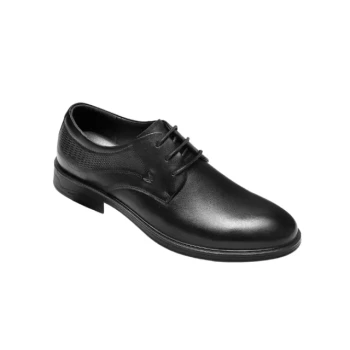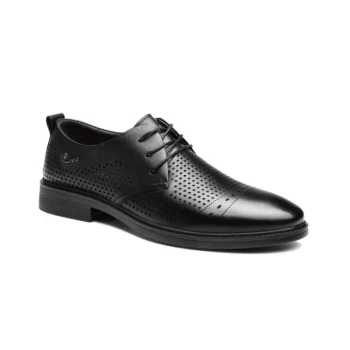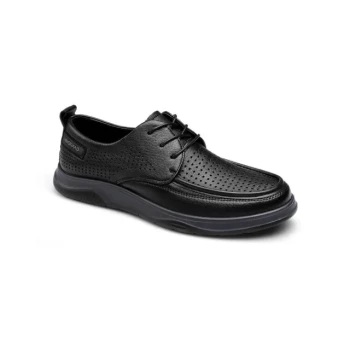To determine the formality of a men's dress shoe, you must assess three core factors: its structure, its color, and its level of ornamentation. The simplest, sleekest, and darkest shoes are always the most formal. Any addition of decorative elements, lighter colors, or more robust construction immediately moves a shoe down the formality scale.
The fundamental principle is that formality in menswear is rooted in minimalism. As a shoe becomes simpler, darker, and sleeker, its formality increases. The most formal shoe is one with clean lines, no decoration, and a deep black color.
The Three Pillars of Shoe Formality
Understanding the core components that dictate a shoe's place in a wardrobe is essential. Each element—from the lacing system to the color—sends a distinct signal.
Structure: Lacing System Defines the Foundation
The primary structural difference in dress shoes is the lacing. A closed-lacing system (Oxford), where the shoelace eyelet tabs are stitched underneath the vamp (the top part of the shoe), creates a clean, uninterrupted line. This makes the Oxford the definitive formal and business shoe.
Conversely, an open-lacing system (Derby), where the eyelet tabs are stitched on top of the vamp, creates a more visible, slightly bulkier silhouette. This construction makes the Derby inherently less formal and more versatile for business casual settings.
Ornamentation: The Impact of Broguing
Brogues are not a style of shoe but rather a pattern of decorative perforations. This detailing has its roots in practical Irish footwear designed to let water drain out.
Because of this rustic heritage, any amount of broguing makes a shoe more casual. The more perforations a shoe has, the less formal it becomes. A "full brogue" or "wingtip" is significantly more casual than a "quarter brogue" with minimal punching.
Color: The Unmistakable Hierarchy
Color is the most straightforward indicator of formality. The spectrum is clear and unforgiving.
Black is the most formal color, and it is the only appropriate choice for black-tie events and the most conservative business environments. Dark brown and deep burgundy (or oxblood) are next, suitable for most business situations. Lighter shades of brown and tan are progressively more casual.
Placing Common Styles on the Formality Scale
Applying these principles allows you to instantly categorize any dress shoe you encounter.
The Peak of Formality: The Black Oxford
A plain or cap-toe black Oxford, free of any broguing, is the gold standard of dress footwear. Its closed lacing, dark color, and minimal design make it the correct choice for everything from serious business suits to tuxedos (when in patent leather).
The Versatile Workhorse: The Derby
The Derby's open-lacing system positions it as the quintessential business casual shoe. It pairs perfectly with sport coats, chinos, and less formal suits. A dark brown Derby is one of the most versatile shoes a man can own, though it remains a step below an Oxford in formality.
The Slip-On Styles: Loafers & Monk Straps
Any shoe without laces is inherently less formal. Loafers, being slip-on shoes, are traditionally considered casual, though sleek leather versions can work in modern business casual offices.
The Monk Strap, which closes with a buckle and strap, sits in a unique middle ground. It is less formal than an Oxford but is often seen as more of a style statement than a Derby, pairing well with more fashion-forward business attire.
Understanding the Trade-offs
Navigating shoe formality requires avoiding common assumptions and mismatches that can undermine an entire outfit.
Confusing Quality with Formality
A beautifully handcrafted, expensive suede loafer is still a casual shoe. It is less formal than a simple, entry-level black Oxford. High price and craftsmanship do not equal high formality.
The Myth of "One Shoe Fits All"
While a dark brown cap-toe Oxford is incredibly versatile, it is not a universal solution. It would be out of place at a black-tie gala, just as a light tan brogue would be inappropriate for a board meeting at a conservative firm.
Ignoring the Toe Shape
The overall sleekness of a shoe contributes to its formality. A shoe with a chiseled, slightly pointed toe aligns with the sharp lines of a suit. A shoe with a very rounded or square toe will always appear more casual and less refined.
Making the Right Choice for the Occasion
Use this framework to select footwear with precision and confidence.
- If your primary focus is Black Tie or the most formal business events: A plain black Oxford, either in patent or highly polished calfskin, is your only option.
- If your primary focus is corporate business and interviews: A black or dark brown/oxblood cap-toe Oxford is the most reliable choice.
- If your primary focus is business casual: Derbies, Monk Straps, and brogued shoes in various shades of brown offer excellent versatility.
- If your primary focus is smart casual weekends: Leather or suede loafers and more decorative brogues are perfectly appropriate.
Mastering these distinctions empowers you to build a functional wardrobe where every choice is intentional and correct.
Summary Table:
| Formality Level | Key Shoe Styles | Ideal Occasions |
|---|---|---|
| Most Formal | Plain Black Oxford | Black-Tie Events, Board Meetings |
| Business Formal | Cap-Toe Oxford (Black/Brown) | Corporate Business, Interviews |
| Business Casual | Derby, Monk Strap | Sport Coats, Chinos, Less Formal Suits |
| Casual | Brogues, Loafers | Smart Casual Weekends, Relaxed Settings |
Ready to build a perfect dress shoe collection for your market?
As a large-scale manufacturer, 3515 produces a comprehensive range of footwear for distributors, brand owners, and bulk clients. Our production capabilities encompass all types of formal and casual shoes and boots, ensuring you get the right styles for every customer and occasion.
Contact us today to discuss your manufacturing needs and elevate your product line!
Related Products
- Wholesale Leather Derby Shoes Manufacturer | Customizable Business & Dress Footwear
- Custom Manufactured Air Cushion Leather Business Shoes for Wholesale
- Wholesale Leather Derby Dress Shoes Custom Manufacturer for Brands
- Factory Direct Wholesale Leather Comfort Shoes with Dial Closure
- Wholesale Training Shoes with Dial Lacing System Custom OEM Manufacturing
People Also Ask
- What should consumers look for to avoid misleading claims about leather quality? A Guide to Identifying Genuine Quality
- Why are quality shoes important for overall appearance? The Anchor to a Polished Impression
- How can one identify authentic leather footwear? A Guide to Spotting Genuine vs. Fake
- What is business casual shoes? Master the Perfect Blend of Professional Style and Comfort
- What are the quarters of a dress shoe? The Key Difference Between Oxford & Derby Styles



















